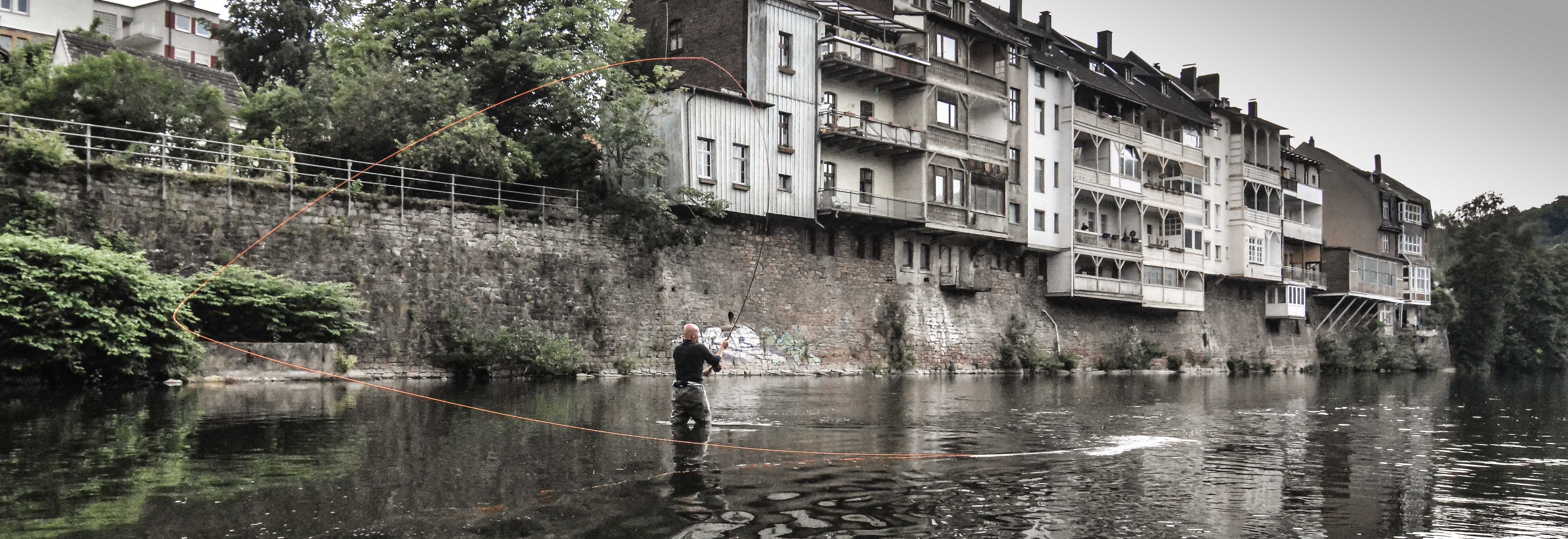Since spring 2009, switchrods have been my greatest addiction. They are ideal tools for fishing my local rivers, and these „one and a half – handers“ suit my fishing style (nymph/streamer fishing) perfectly. I have been practicing this fishing style using the singlehanded rod for decades, and with the new hybrids, this is great fun and easy to handle, with lots of advantages! 20 meters of distance and controlled fishing with hardly any backspace. Gradually, my overhead casting has dropped to practically nil.
My main weapon is a #5-110-4 with matching shooting head/poly leaders, an elegant „floret par excellence“. Fishing my local rivers exclusively in spey style and wet-fly-swing is pure joy! However, I was often confronted with one specific, adverse player in my heavenly spey-galaxy: If, for whatever reason, the line mass (the belly/head) beyond the rod tip is gone, the spey jedis – lights word lacks energy. Nothing there to load the rod against!
In the real world, I am often stuck in fishing spots where you can’t move up/downstream and you have to cover the whole water from one spot, especially the downstream stretch. I think you know the spots I’m talking about from your own experience!?
Fishing these spots with a singlehander is quite easy: strip the streamer actively to your feet, cast the line out again with overhead or rollcast moves. However when fishing with switch rod /double handers and a shooting head, you normally stop fishing at the sweetspot position of the head with optimal overhang, which is around 18 meters downstream (3.3m rod, 10m head and overhang, 3m polyleader, 2m tippet) from your position, then going into a single/snap/dump/poke or whatever WITH the line mass outside of the rod tip.
If you strip any further, you have to cast out the main mass again in order to speycast properly. I solved the problem this summer by simply overhead casting with my switchrod to cast out the head again, then changing into spey, which is indeed possible.
But this ain’t cool! Overhead casting with a speyrod!
Obi Wan wouldn’t have done it that way and Darth Mass would have exclaimed a metallic laugh – „overhead casting with a speyrod… give me a break!“
I would like to introduce you to my technique to defeat the enemy Darth Mass in Obi Wan style! I’ll try to describe a move to cast out the nearly totally stripped in mass/head with a switchrod/doublehander elegantly, harmonically and effectively without any unnecessary movement or overhead casting. After casting out this line mass again, the lightsword is re-energized and you’re ready for action. So the actual part/move I’m describing is the part BEFORE the normal speycast with sustained anchor/circleup/keyposition/fire.
Enough Star Wars analogies. Let’s cast!
For the purpose of easy and comprehensible description I use the move in the following situation:
- River left
- Upstream wind
- Caster is right handed
Before I describe the move, I recommend you have a clarifying look at these demo video on Youtube:
Casting the Snap Slip Spey in SloMo
http://www.youtube.com/watch?v=dw5uf37q_vo
Please excuse, that the river section I did this video in, is a tad too small for the cast. I hit the far bank bushes at the end of the cast.
The demonstrator SNAPS with nearly zero line upstream, SLIPS the whole shooting head in front of him in a clean half circle to the exact and perfect sweet spot position without any slack line, and is then ready to go in a conventional sustained anchor circleup/keyposition/fire SPEY cast.
The secret lies in the preparation phase for the Snap-Slip. This is done by controlling TWO line segments as marks, while stripping in the line.
Here is the sequence:
MARK 1: While stripping in and reaching the sweetspot position, mark this running line segment between the pinky/index finger of your left hand and hold the mark firmly:
